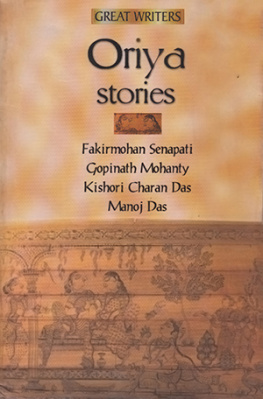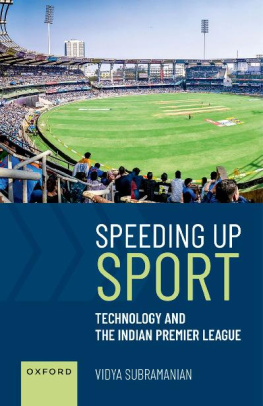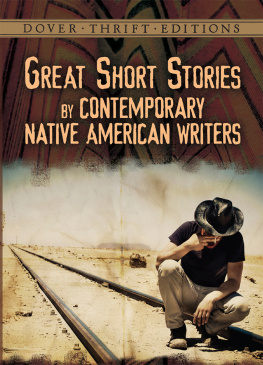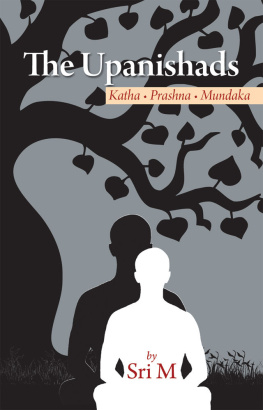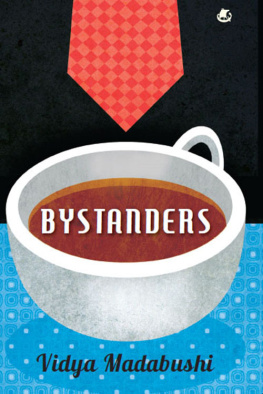Vidya Das - Oriya Stories (Great Writers)
Here you can read online Vidya Das - Oriya Stories (Great Writers) full text of the book (entire story) in english for free. Download pdf and epub, get meaning, cover and reviews about this ebook. year: 2009, publisher: Srishti Publ., genre: Non-fiction. Description of the work, (preface) as well as reviews are available. Best literature library LitArk.com created for fans of good reading and offers a wide selection of genres:
Romance novel
Science fiction
Adventure
Detective
Science
History
Home and family
Prose
Art
Politics
Computer
Non-fiction
Religion
Business
Children
Humor
Choose a favorite category and find really read worthwhile books. Enjoy immersion in the world of imagination, feel the emotions of the characters or learn something new for yourself, make an fascinating discovery.
- Book:Oriya Stories (Great Writers)
- Author:
- Publisher:Srishti Publ.
- Genre:
- Year:2009
- Rating:5 / 5
- Favourites:Add to favourites
- Your mark:
- 100
- 1
- 2
- 3
- 4
- 5
Oriya Stories (Great Writers): summary, description and annotation
We offer to read an annotation, description, summary or preface (depends on what the author of the book "Oriya Stories (Great Writers)" wrote himself). If you haven't found the necessary information about the book — write in the comments, we will try to find it.
Oriya Stories (Great Writers) — read online for free the complete book (whole text) full work
Below is the text of the book, divided by pages. System saving the place of the last page read, allows you to conveniently read the book "Oriya Stories (Great Writers)" online for free, without having to search again every time where you left off. Put a bookmark, and you can go to the page where you finished reading at any time.
Font size:
Interval:
Bookmark:
ORIYA
Stories
ORIYA
Stories
Fakirmohan Senapati
Gopinath Mohanty
Kishori Charan Das
Manoj Das
Selected & Edited by
Vidya Das

Srishti
Publishers & Distributors
Srishti Publishers & Distributors
64-A, Adhchini Sri
Aurobindo Marg
New Delhi 110 017
First published in 2000 by Srishti Publishers & Distributors
Copyright Srishti Publishers & Distributors 2000
Copyright for each individual story in its
original language is held by the author.
Copyright for the English translations rest with
Srishti Publishers & Distributors
ISBN 81-87075-61-9
Rs. 145.00
Cover Design and Typeset by
Arrt Creations
45 Nehru Apartment, Kalkaji,
New Delhi 110 019
e-mail:
Printed and bound in India by
Saurabh Print-O-Pack, Noida
All rights reserved. No part of this publication may be reproduced, stored in a retrieval system, or transmitted,in any form or by any means, electronic, mechanical, photocopying, recording, or other wise,without the prior written permission of the Publisher.
Contents
Acknowledgements
Introduction
FAKIRMOHAN SENAPATI
Rebati
Translated by Kishori Charan Das
Ananta , the Widows Son
Translated by Jayanta Mahapatra
Patent Medicine
Translated by Jayanta Mahapatra
GOPINATH MOHANTY
Ants
Translated by Sitakant Mahapatra
The Garden
Translated by Kishori Charan Das
Tadpa
Translated by Sitakant Mahapatra
KISHORICHARAN DAS
Saramas Romance
Translated by Sumanyu Satpathy
Godless
Translated by the author
The Hundred Sons
Translated by the author
MANOJ DAS
The Bull of Babulpur
Translated by the author
Farewell to a Ghost
Translated by the author
The Submerged Valley
Translated by the author
Glossary
Notes on authors
Acknowledgements
My grateful thanks to the translators and publishers for the stories of Fakirmohan Senapati; to the authors family, translators and publishers for the stories of Gopinath Mohanty; and to the authors and publishers for the stories of Kishori Charan Das and Manoj Das.
Fakirmohan Senapati: His stories were originally published in journals. They were subsequently compiled many times over by several publishers, including Friends Publishers, Cuttack. In a recent edition, Fakirmohan Granthabali - Galpamala, Cuttack: Friends Publishers, 1999, the researcher and editor Dr Kailash Patnaik cites the following publishing details: Rebati in Utkala Sahitya, nd Year, No. 10, October 1898; Randi Pua Ananta ( Ananta, the Widows Son) in Mukara , 8 th Year, No. 4, July 1913; Patent Medicine in Utkala Sahitya , 17 th Year, No. 5, August 1913.
Gopinath Mohanty: His stories were originally published in journals and were collected into a few volumes after his death. Pimpudi ( Ants ) and Bagicha ( The Garden ) in Chhai Alua, Cuttack: Friends Publishers, 1992; Tadpa in Baghei, Cuttack: Friends Publishers, 1995.
Kishori Charan Das: Saramara Romance ( Saramas Romance ) in Bhanga Khelana , Jeypore: Bikash Pratisthan, 1961; Bidharmi ( Godless ) in Laksha Bihanga , Cuttack: Jagannath Rath, 1968; Sake Pua ( The Hundred Sons ) in Manihara , Cuttack: Lark Books, 1970.
Manoj Das: Babulpurara Sandha ( The Bull of Babulpur ) in Manoj Dasanka Katha O Kahani, Cuttack: Friends Publishers, 1971; Bhutuni: Eka Bidaya ( Farewell to a Ghost ) in Lakshmira Abhisara, Cuttack: Grantha Mandir, 1971; Magna Upatyaka ( The Submerged Valley ) in Panchavimsati , Cuttack: Grantha Mandir, 1983.
My thanks to Rani Ray, without whose encouragement and insistence this volume would not have happened.
Introduction
Modern prose writing in Oriya began, as in other Indian languages, in the second half of the nineteenth century. In most parts of India, the complex interaction between two factors contributed to the emergence and shape of the new writing colonial modernism via European thought and literature and a growing nationalist consciousness as evidenced in the concerns of identity and socio-political change.
In Oriya literature, however, the former had little immediate influence, distanced as Orissa was from centres of power, and ignored by the British except for its natural resources. The reasons for this and the circumstances that led to the emergence of the literature, with its distinctive quality of rootedness, is often forgotten. Despite Orissas ancient artistic and cultural heritage and the fact that Oriya is almost a 1000 year old language with an established literary tradition, modern Oriya writing arose from an urgent need to preserve the language and prevent the submersion of an Oriya identity. That the language and the culture have shown such resilience is significant given the specific history of the state.
Long past the Kalinga and Utkal periods, Orissa was invaded in turn by the Mughals, the Afghans and the Marathas. It had no stable central power and was split into semi-independent principalities. This led to the gradual political amputation of Orissa into separate parts that were annexed to neighbouring states. When the British occupied Orissa in 1803, taking over from the extremely weakened Marathas, this vivisection was consolidated with the separation and attachment of Oriya speaking regions to the Madras, Bengal and Central provinces for reasons of commercial and administrative expedience. Other parts were governed as feudatory states, unconnected to these administrative districts.
Thus, by the middle of the nineteenth century, though bound together both linguistically and through abiding community, social and religious practices (the most visible cultural marker being the cult of Jagannath, with its seat Puri providing a sense of cohesion), the Oriya people themselves were dispersed and dispossessed.
The disintegration of Orissa had of course begun much before British rule and it had suffered greatly under the petty rulers and the terror tactics of the Marathas who came after the Mughals. But the livelihood of the people had continued much as before. The systematic destruction and upheaval that took place within a short time of British occupation was unprecedented. The trade policies virtually wiped out the cottage industries of handloom, leatherwork, filigree and other handicrafts that were the traditional livelihood of the Oriyas. And monopoly over the sale and manufacture of common salt took away the economic mainstay of the people of coastal Orissa. The revenue policies and the notorious Sunset Law that accompanied it ensured that the rich too were deprived of their lands and uprooted. Many in desperation got their lands settled in the name of temple authorities, relying on the British policy of not interfering with religious institutions and also, somewhat naively, on the honesty of the priests. Resistance of any kind, such as the famous Paika rebellion, only led to further deprivation and displacement. By the second half of the century, the people depended almost entirely on agriculture for their living. These Oriya areas, however, were largely treated as the backwaters of the provinces they were attached to, with no railway lines or irrigation systems being set up by the administrators to develop them.
Oriya literature had survived all these changes, though it had moved away from its unique origins in the voice of the masses without aristocratic support to a highly Sanskritised stage under the patronage of feudal courts. However, modern Oriya writing emerged only when it began to be felt that political dispersal could lead to the erasure of Oriya identity itself, and when administrative homogenisation threatened to become a linguistic and cultural one as well.
Next pageFont size:
Interval:
Bookmark:
Similar books «Oriya Stories (Great Writers)»
Look at similar books to Oriya Stories (Great Writers). We have selected literature similar in name and meaning in the hope of providing readers with more options to find new, interesting, not yet read works.
Discussion, reviews of the book Oriya Stories (Great Writers) and just readers' own opinions. Leave your comments, write what you think about the work, its meaning or the main characters. Specify what exactly you liked and what you didn't like, and why you think so.

